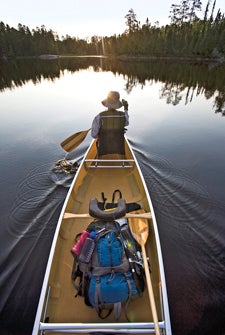No Country for the Old Man
Minnesota's Boundary Waters
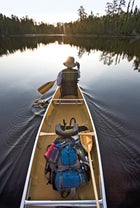 Minnesota's Boundary Waters
Minnesota's Boundary WatersThe secret to backcountry paddling with Dad? Patience. And brandy.
“THIS COULD BE a Titanic mission,” my father, James, says as we drive toward Minnesota’s Boundary Waters Canoe Area Wilderness. He’s explaining his newly purchased canoe, which came at a discount due to a weak spot in its Kevlar laminate that may or may not lead to us sinking.
“Sounds about right,” I say.
We’re here to celebrate Dad’s impending retirement. A former Peace Corps volunteer who took up skydiving during a midlife crisis, he’s now prepared to call it a career after nearly four decades running a sunflower-processing business. We chose the Boundary Waters because it’s a place he’s always wanted to visit and one that I know intimately. He picked me up at the airport, his defective canoe teetering on the car’s roof, and later, at the hotel, invoked his newly acquired AARP discount. Once in the room, he attached an air ventilator to his face, Snuffleupagus style, in order to thwart sleep apnea.
The next morning, a steady rain lashes our faces as we paddle out. Every third stroke, my father mindlessly splashes water in my lap while extolling the virtues of his new bent-shaft paddle, which he purchased on the advice of a how-to book.
“How’s she look?” he asks.
“If you hold it more upright,” I say, “it’ll be easier to paddle, and you won’t waste so much energy splashing.”
“Technique,” my father says, “is overrated.”
Toward the end of the day, I suggest a campsite on an island in Canadian waters. “Too open to the wind,” Dad says. Two hours later, we pull into a site on Birch Lake, the only spot we can find that’s even slightly sheltered. I suggest a fire. Dad wants to crash, so we set up the tent and I cook dinner on a camp stove in the tent’s vestibule as the rain hammers down. “This sucks,” Dad says.
The next day, while eating lunch on a rock outcropping under a soaking drizzle, Dad suggests raiding the leftover firewood from a nearby campsite. “Not kosher,” I say. But he’s made up his mind; we dump the wood in the boat and paddle on.
Eventually, the sun begins to break through. He asks me about my job and my love life. I tell him that I live in a desert and that I’m not referring to the geography.
“You’re not getting any younger,” he says.
“This coming from a man who sleeps on life support,” I say.
That night we drift out in front of our camp┬şsite with a bottle of brandy and two rods. We catch three walleyes. Onshore, I fry them in bread crumbs, and we eat in silence as the moon rises above the silhouettes of white pines on a distant ridgeline. Afterward, for perhaps the first time, my father compliments my cooking. I begin packing up the campsite, and before I can stop him he dumps the leftovers in the fireÔÇöa major faux pas.
“What the hell?” I say. “You know there are bears here.”
“Yeah, yeah,” he says. “If you’re this fasti┬şdious about the campsite, how come your apartment is such a mess?”
I pick up the bottle of brandy and polish it off. There’s nothing else to do.
“Good trip,” Dad says. “Where to next?”
EXPENSE REPORT: One night at Canoe On Inn in Ely (): $88. Two fishing licenses (): $50. Maps, freeze-dried food, and blueberry scones at Piragis Northwoods Company (): $67. Bottle of brandy: $26. Post-trip steaks and cocktails at Ely Steak House (): $93. Total: $324
Welcome to the Jungle
On a long weekend in Los Angeles, anything goes. Even semiautomatic weapons.
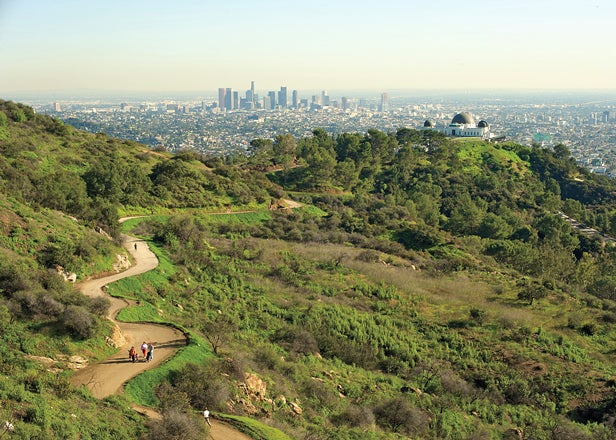
I’M NOT HERE for the silicone or Bentleys. I don’t want to get my picture taken with a Marilyn Monroe impersonator. I’ve come to grind my teeth on a little of L.A.’s sweet grit.
My buddy JamesÔÇöa fast-talker with wild eyes and a grizzly bear of a beardÔÇöpicks me up at LAX. He’s lived here for three years but still keeps a GPS on the dash. “This city,” he says, “makes no sense.” He’s talking about more than the tangle of roadways. He’s talking about a city that is not so much a city as it is a mess of neighborhoods, each with its own personality, making L.A. a kind of smog-belching, schizophrenic beast.
We park along the L.A. River at Atwater Village and step into the concrete channel. I have alternating views of the freeway and the mist-haloed San Gabriel Mountains. This is not the barren watercourse from Terminator 2. Bass populate the river. Horseback riders splash along its banks. There are islands thick with trees that are decorated with garbage. I quickly spot a dozen species of waterfowl.
Ducks honk. Semis blast their horns. A group of spandex-clad bicyclists races by on the riverside path. James and I find a tunnel, full of graffiti and shadows and broken glass, that takes us under the freeway. When we emerge, we are at the doorstep of 4,000-acre Griffith Park, one of the largest urban wildernesses in the country.
We enter the 53-mile network of trails, and soon trees crowd around us, hushing the grumble of the city. At the end of our seven-mile hike, the sun begins to set, and the neon glow of the city makes the sky a bruised purple. We drive to Koreatown and Masan, a restaurant known for its monkfish stew, which we order, along with live octopus. The legs twist on our plates like dying snakes, and I chew them to a pasteÔÇöif you don’t, the suckers can latch on to your tongue.
“You want dessert?” James asks, and I say, “I want to shoot some guns.”
Just past Skid Row we find the Los Angeles Gun Club, the kind of nondescript building that could pass for a paper-clip warehouse. Then you approach the door and hear the snap-snap-snap of muffled gunfire. Inside, the air is heavy with gun oil, and the walls are busy with racks of every firearm you can imagine. James and I opt for an AR-15, an assault rifle that jerks in my arms like something alive as I fire rounds down lane four. I am surrounded by men with forearm tats who fire pistols while their girlfriends clap and squeal. After blasting my way through three bricks of ammo, my hands are trembling and I can’t shake the grin from my face.
“What do you think?” James asks.
“Unreal,” I say.
EXPENSE REPORT: Hiking the L.A. River and Griffith Park: free. Dinner at Masan (213-388-3314): $60. Guns (): $90. Drinks at HMS Bounty (213-385-7275): $100. Breakfast at the Trails (323-660-8006): $5. Thai noodles at Sanamluang Cafe (818-764-1180): $12. In-N-Out Burger stop: $10. Ice cream at Scoops (323-906-2649): $5. Total: $282
Alien Territory
A paranormal road trip through New Mexico's forgotten Gila National Forest.
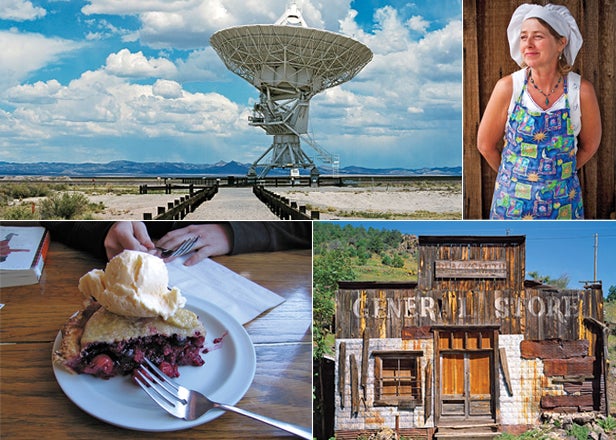
WHEN MY GIRLFRIEND, Marin, and I drove into the ghost town of Mogollon (unofficial pop. 15) last July, we thought we’d be treated to the same tourist show we’d seen all over the West. We also thought we’d be checking into just another B&B in southwestern New Mexico, but the 126-year-old Silver Creek Inn is not so much a hotel as a labor of love. The inn’s lanky owner, Stan King, 65, who prefers Vibram FiveFingers to shoes, has been renovating the place with his bare hands for 31 years. Every summer, he opens up the inn and, if you’re lucky, calls in his friends to whip up a feast (salmon and home-baked bread) in the common room.
At dinner, Stan’s buddy John told stories about phone phreaks, proto-hackers who manipulated dial-tone frequencies in the 1970s to get free long distance. Also joining us was Stan’s old flame Susi, who designs “quantum geometries” from her solar-powered schoolbus, living on $400 a year. “People say that folks like us dropped out,” she said. “We like to say that we dropped in.”
The Gila is a forgotten place, sandwiched between the civilized parts of Arizona and New Mexico. It’s the region where Geronimo eluded American troops for years. It’s home to the world’s first designated wilderness area (1924), now a refuge for the endangered Mexican gray wolf. There are also cheesy getaways like Sundial Springs, with three natural hot springs that have crystals arrayed around their rims and the occasional bighorn sheep walking by on the far ridge.
While most people look for New Mexico’s legendary sci-fi weirdness east of here (Roswell, Trinity Site, Richard Branson’s Spaceport), the Gila feels like a grainy B movie come to life. Up north in the Plains of San Agustin, you’ll find the Very Large Array, where 27 huge parabolic dishes measure the deepest reaches of the universe. Standing before one of these while it skews its angle is like witnessing the prelude to a Rebel Alliance attack on the Death Star. In Quemado, a thrift store with the sign ALTERNATIVE HEALING MAGIC CARD READINGS will lure you. The owner, Elaine, will tell you about the ghost haunting the bathroom. Spend a night at The Lightning Field, Walter De Maria’s 1977 installationÔÇöa sprawling grid of 400 lightning rods outside QuemadoÔÇöand you’ll expect sparks to fly. When lightning doesn’t come you’ll walk the field, and even hallucinogen-free, you’ll find yourself writing a screenplay about armies of zombie horned toads.
In the Gila, you’ll remember that the real roadside attractions are the little things you find in the middle of nowhere. (In New Mexico, nowhere has many middles.) And then you might wonder if this is where the ETs actually landed.
EXPENSE REPORT: One night at the Silver Creek Inn (): $150, breakfast included. Mogollon Museum (): $5 donation. Three old guys playing bluegrass in Mogollon: $3 tip. Soak at Sundial Springs (): $20. Very Large Array: free. Pie at Pie-O-Neer in Pie Town (): $12. The Lightning Field (): $300, dinner and breakfast included. Total: $490
Swamp Things
Out with a frog whisperer on Mississippi's Pascagoula River.
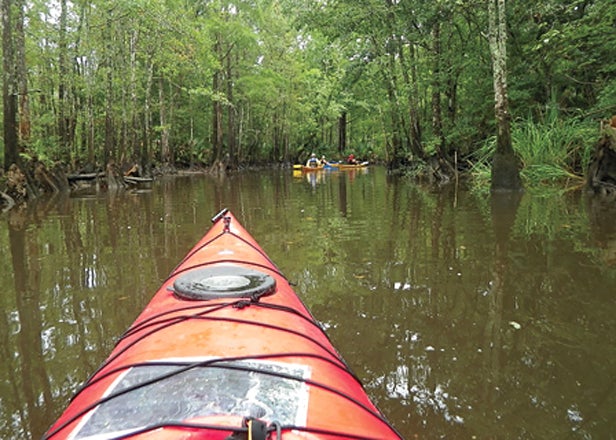
MY BUDDY DON LIVES on a bayou in Mississippi. He fly-fishes all the time. His girlfriend is a Pilates instructor who likes to bake bacon pralines. Don’s got the life.
To get me some of that life, I convinced Don to show me the Pascagoula River swamp, just east of his home. The Pascagoula is one of the largest free-flowing rivers in the lower 48. Don’t feel bad if you’ve never heard of it; the Pascagoula is the Gulf Coast’s best-kept secret. It has no whitewater. What it does have is the biodiversity of a tropical rainforest. Its bayous weave through 9,600 square miles of wilderness. At least 109 species of fish have been found in the Pascagoula, including endangered ones like the Gulf sturgeon, which has been nosing through these waters for 63 million years. Hundreds of bird species depend on the swamp. Ivory-billed woodpeckers are rumored to still haunt it.
Don and I met up with Gene Cossey, a 23-year-old guide for the South Coast Paddling Company. Gene lives near the swamp, and from the time he could walk, he’s been eating things from it: bass, mullet, gar, redfish, crappie, crawfish, frog, duck, nutria, beaver. Gene is locally renowned for his stir-fried Szechuan beaver.
We put in our kayaks at a place called Poticaw Bayou and slipped beneath a canopy of oak, sweet gum, and swamp maple. Floating shacks, fish camps, and, in one case, what appeared to be a camper driven onto a barge lined the main channel; many were decorated with antlers, skulls, fishing poles, grills, and sofas on the porches. “Certain people out here you don’t want to meet,” Gene allowed.
A few miles downstream, bald cypress took over, jutting their skeletal selves out of the marsh grass, platforms for osprey nests. By midday the trees gave way to reeds. No shade. Mississippi. July. Sweat. After convincing Gene to take us frog-gigging that night (Don had told me that Gene’s grilled frog legs were to die for), we retreated to Don’s for some Southern Pecan Nut Brown Ale.
At dusk we slid Gene’s skiff into an old oxbow lake. Cypress trees dripping Spanish moss rose out of the shallows like columns in an ancient flooded temple. We poled the skiff through them, breaking spiderwebs with our faces. Alligators’ red eyes submerged as we passed. Tree frogs trilled in the ferns. Cicadas crackled. Croak croak went the banks. Something about cypress swamps tugs at your inner hunter-gatherer.
Don froze a bullfrog in our spotlight high on one bank. It was the size of a goddamn chicken. I squatted in the bow with my right arm pulled back, the ten-foot spiked metal gig in my hand. We inched toward shore. “Hold still, baby,” I whispered. At last I was within range. I waited, took a breath, and jabbedÔÇöway, way too slow. The tip of my gig thwacked into the bank as the frog launched itself straight at my head. I made the kind of squeak that no man in a Mississippi swamp should ever make. The frog glided past my ear into the water. Somebody snickered. And my inner hunter-gatherer started thinking about the rest of the beer back at Don’s.
EXPENSE REPORT: Two nights at the Days Inn Moss Point Pascagoula (): $132; or at Bluff Creek Campgrounds, 20 minutes from Poticaw Bayou (): $60. Full-day guided kayak tour (; ask for Gene): $60. Evening guided frog gigging (ask Gene real nice): $60. Two out-of-state small-game licenses (): $69. Boiled peanuts for lunch: $4. Two shrimp Creole dinners at Aunt Jenny’s Catfish in Ocean Springs (228-875-9201): $30. One six-pack of Lazy Magnolia Brewing Company’s Southern Pecan Nut Brown Ale: $8. Total: $291ÔÇô$363
Wash Out
A long, wet trip from Vermont to the Adirondacks' highest peak.
ON THE FIRST OF OCTOBER last year, flights into Burlington, Vermont, were delayed and state employees were sent home from work early due to the rain. It ran down gutters in brown rivers, transformed rivers into flood zones, and blew laterally, battering our ponchos as we pedaled toward the City Market. My friend Chris and I planned to take three days to bike from Burlington to Lake Champlain, canoe across at Charlotte, ride to New York’s Mount Marcy in the Adirondacks, hike up, and return: 119 miles, two states, one mountain (at 5,344 feet the biggest we New Yorkers have), and one grumpy body of water.
The weather complicated things, but only slightly. Chris is that friendÔÇöthe one with whom I snuck first beers, stole street signs, drove to Montana on a whim, and otherwise negotiated the briars of suburban adolescence. We do storms. After loading up our panniers with sesame sticks, bread, and salami, we pedaled south, mid-cataclysm, our socks turning to water balloons.
“What’s wrong with you?”
A fair question, posed by the ferry toll collector at Charlotte, a nice lady in a dry-looking booth. Still, we stared out at the lake. We’d spent months plotting our route, scouting a place to stash the canoe (the backyard of an unsuspecting resident), and otherwise reveling in the minutiae of manufactured adventure. BoatsÔÇönone of them canoes, none of them balancing bikesÔÇörolled on whitecaps. The lake appeared as though it would have been mildly amused to swallow us. The ferry’s horn blared. We left the canoe, climbed aboard, and froze in Champlain’s spray.
But water crossings have a way of changing things. In New York the roads flattened, the skies softened, we changed shirts. There was a caf├ę in the town of Wadhams that served a fierce gumbo, which we followed up with a slow 7.5-mile climb to the lip of the Adirondacks and a whizzing descent to the town of Keene Valley, which included two essential establishments. One was a bike shop that sold brake pads for my squealing ride. The other was a deli that sold beer, which we hauled to the first lean-to on the trail up Marcy.
The next morning, we awoke and started our slog up the trail, which bore a striking resemblance to a river thanks to Friday’s hydraulics. In places, it would have made good trout habitat. Still, there was trafficÔÇöcollege students, couples, a guided high school trip. After three wet hours, we were at the top, wringing out our socks in silence, contemplating the red roll of New York, the deep blue of Champlain, and the soft hills of Vermont beyondÔÇögeologic evidence of a half-baked idea partly executed.
That moment was, as they say, the point: bad salami and a good view. The quiet, shared recollections of the summer when we were 18 and learned to drive a stick shift in traffic on Lake Shore Drive in Chicago, dreaming about the mountains we would find in Montana. The temporary illusion of immunity to the effects of computers and commutes andÔÇö”Yeah, dude. I get reception. I’m on Marcy.”
We turned: a child with a backward cap, possibly 18, possibly 12, possibly a cyborg, barked into his cell phone.
We laughed, put the water balloons back on our feet, and headed down the trail, hoping no one had stolen our bikes.
EXPENSE REPORT: Bear canister, freeze-dried food, camp fuel, tubes, whiskey, and ponchos: $192. Groceries from City Market (): $43.50. Two round-trip ferry tickets (): $15. Gumbo at Dogwood Bread Company in Wadhams (): $12.50. Brake pads from Leep Off Cycles in Keene Valley (518-576-9581): $13. Beer from Valley Grocery in Keene Valley (518-576-4477): $10. Breakfast at Noon Mark Diner in Keene Valley (): $21. Total: $307
Cohos Trail, New Hampshire
Uncrowded Territory
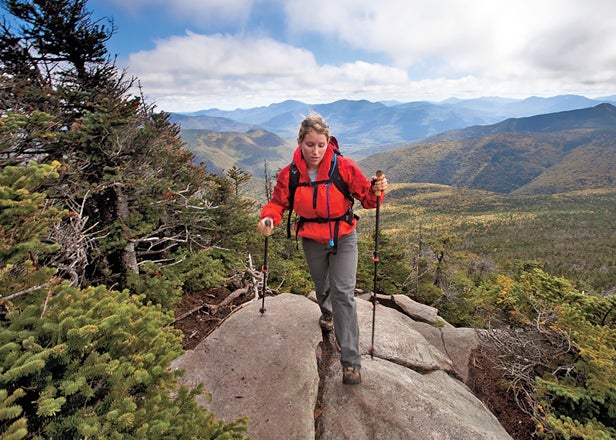
Leave the White Mountains’ tourists behind on the 165-mile Cohos Trail, which stretches from the edge of the Whites through the Dartmouth, Pliny, and Pilot ranges to Canada. Stay at the Stark Village Inn; owner Nancy Spaulding will shuttle your car to Dixville Notch and drop you at the trailhead near Stark, the beginning of your 25-mile hike. There’s plenty to see: high alpine meadows, waterfalls, a 700-foot cliff, and a natural pool in the Nash Stream near mile ten. Spend your last night at the Baldhead lean-to at mile 17, overlooking the Presidential Range.
NEAREST AIRPORT: Manchester, 2.5 hours.
EXPENSE REPORT: One night at the Stark Village Inn (603-636-2644): $55. Tip for shuttle: $20. Camping provisions: $75. Flask: $10. Post-hike seafood platter and poutine at Northland Restaurant and Dairy Bar in Berlin (603-752-6210): $40. Total: $200
Greenville, Maine
Lakeside Lounging
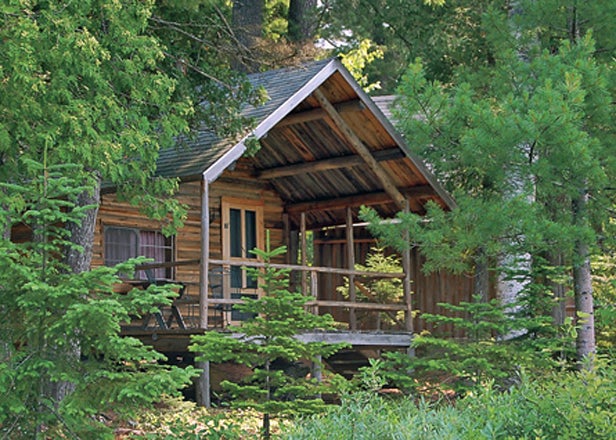
The Appalachian Mountain Club’s Gorman Chairback Lodge and Cabins opened in January on the shore of Long Pond in the Moosehead Lakes region, surrounded by 66,000 acres of protected wilderness and more than 70 miles of trails. Bring your fly rod to fish for wild brook trout in nearby ponds, or borrow one of the lodge’s canoes and paddle around. After dinnerÔÇöserved communally and usually capped with homemade dessertÔÇösit on your cabin’s porch watching the stars go nuts. Sunday: repeat.
NEAREST AIRPORT: Portland, three hours.
EXPENSE REPORT: Two nights at the Gorman Chairback Lodge, including all meals (): $456. Two fishing licenses (): $22. Gorp: $5. Bottle of wine: $10. Total: $493
Curt Gowdy State Park, Wyoming
Western Flow
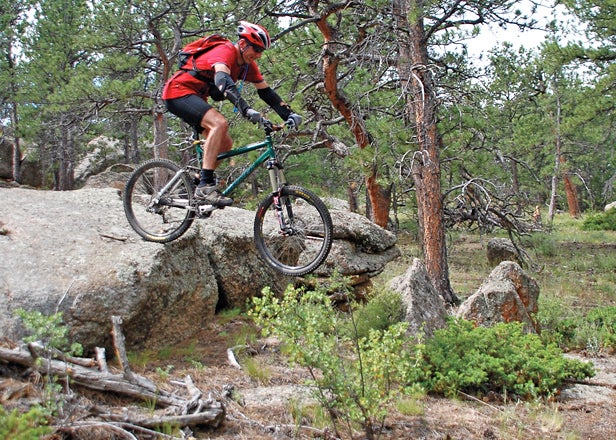
The 3,500-acre Curt Gowdy, two hours north of Boulder, Colorado, offers 35 miles of mountain-bike trails that are so well designed (think dirt singletrack and six-foot jumps), the International Mountain Bicycling Association is holding a regional summit there in September. Beat the crowds by heading out on intermediate-friendly, 3.8-mile Stone Temple Circuit, which links up with at least six spur trails. You’ll wiggle past giant granite boulders and blast through aspen groves. Afterward, head 24 miles west to Laramie for a hearty meal before crashing at the Vedauwoo campground in the Medicine BowÔÇôRoutt National Forest.
NEAREST AIRPORT: Denver, two hours.
EXPENSE REPORT: Two daily-use fees at Curt Gowdy State Park (): $12. Enchiladas and drinks at Sweet Melissa’s in Laramie (307-742-9607): $30. Breakfast at Coal Creek Coffee Company in Laramie (): $18. Campsite at Vedauwoo (307-745-2300): $20. One night at the Mad Carpenter Inn in Laramie (): $85. Two two-day mountain-bike rentals from Full Cycle Bikes in Fort Collins, Colorado (): $200. Total: $365
Black Hills, South Dakota
Crag Heaven
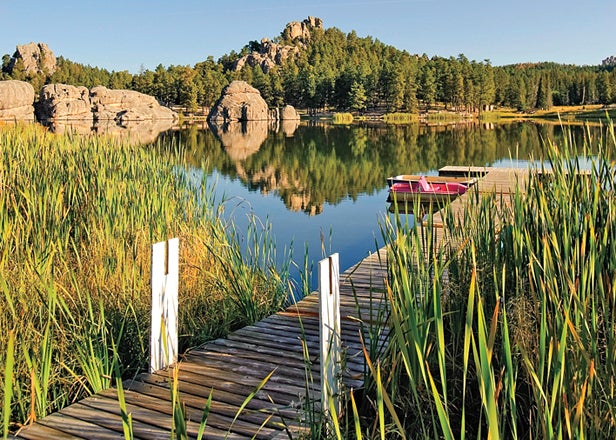
The Black Hills are best known for Mount Rushmore, where a parking garage blocks the roadside view of the presidents’ faces. This is a good thing: while tourists jostle for parking, Custer State Park’s world-class climbingÔÇödozens of 5.3 to 5.10-plus routesÔÇöis up for grabs. If you’re a rookie, hire a guide from Sylvan Rocks Climbing School and Guide Service, then camp at Custer’s French Creek Natural Area. If you have climbing gear and know how to use it, crash at the park’s Sylvan Lake Lodge and indulge in wild buffalo tenderloin in the dining room.
NEAREST AIRPORT: Rapid City, one hour.
EXPENSE REPORT: Park entrance fee (605-223-7660): $15. Two nights camping (): $48.50. Camp provisions: $70. One day of guided climbing for two (): $350. Total: $483.50. Or self-guided with buffalo dinner and one night at the Sylvan Lake Lodge ($250; ): $359.25
Ocoee River, Tennessee
Southern Splash
In summer, the Ocoee River becomes a rowdy party grounds. Join the flotilla on a ten-mile float with Ocoee Rafting that hits more than 40 Class IIIÔÇôIV rapids. Then chow down on brisket at Michael’s Casual Dining in nearby Etowah and drive 13 miles to Reliance for a slice of quiet. Your hot-tub-equipped cabin at Mountain Stream Lodging is buffered by the Cherokee National Forest and the Hiwassee River. The next day, hike the six-mile John Muir Trail, fly-fish, or bring your mountain bike and ride 11.5 miles out and back on the Clemmer and Benton Falls Trails.
NEAREST AIRPORT: Atlanta, three hours.
EXPENSE REPORT: One-day raft trip for two (): $180. Two nights in a cabin (): $230. Smoked brisket dinner at Michael’s Casual Dining (): $25. Breakfast and grilling provisions: $40. Total: $475
Winthrop, Washington
Rock the Tube
The beauty of the Methow Valley is in the options: rafting, tubing, hiking, bouldering, microbrew swillingÔÇöit’s all here. Base yourself in the town of Winthrop (pop. 393), at the Chewuch Inn and Cabins, and swing by Winthrop Mountain Sports () for info and emergency gear needs. On Saturday, head 14 miles northwest to tiny Mazama and spend a couple of hours bouldering around Fun Rock, a series of crags just outside town. Then head 20 miles west, park at Rainy Pass, and hike the seven-mile Maple Pass loop trail, which puts you on a ridge overlooking the Cascades. Sunday is for floating down the Methow River (slowly, in a tube). Rent your tube and arrange a shuttle from Osprey River ║┌┴¤│ď╣¤═°sÔÇöthey’ll meet you at the put-in at River Run Inn and drive you back at day’s end.
NEAREST AIRPORT: Seattle, 4.5 hours.
EXPENSE REPORT: Two nights in a cabin (): $270. Two tube rentals with shuttle (): $50. Sandwich fixings from the Winthrop Red Apple Market (): $20. Pesto-chicken pizza dinner from East 20 Pizza in Winthrop (): $24. Post-float splurge dinner of elk osso bucco, pappardelle, and a bottle of wine at the Arrowleaf Bistro in Winthrop (): $92. Total: $456
Cape Ann, Massachusetts
Coastal Clearer
Just 40 miles north of Boston, Cape Ann is less trafficked than Cape Cod but no less beautiful, with rocky coastline, sandy beaches, and colonial fishing towns. Rent a sea kayak at the North Shore Kayak Outdoor Center and paddle 2.5 miles to Thacher Island, or hop aboard Cape Ann Whale Watch’s 115-foot boat to watch breaching humpbacks. Dinner is lobster rolls on the rocks overlooking Folly Cove.
NEAREST AIRPORT: Boston, one hour.
EXPENSE REPORT: Two nights at the Sea Lion Motel (): $288. Two half-day sea-kayak rentals (): $70. Two lobster rolls at the Lobster Pool Restaurant (): $25. Two whale-watching tickets with Cape Ann Whale Watch (): $90. Total: $473
Thompson’s Harbor State Park, Michigan
Northern Exposure
The newly renovated Cedar Haven Cabin in Thompson’s Harbor State Park offers beds for six, a gas stove, and access to 7.5 miles of Lake Huron coast and more than 5,000 acres of rugged forest. Hike six miles of wooded trails, then ramble along the rocky shoreline with an eye peeled for bald eagles. The next day, go scuba diving among the shipwrecked schooners of nearby Thunder Bay National Marine Sanctuary with Great Lakes Divers and Sweetwater Charters.
NEAREST AIRPORT: Traverse City, three hours.
EXPENSE REPORT: Two nights at the Cedar Haven Cabin (; book a month in advance): $130 for up to six. Out-of-state parking permit (): $29. Camp provisions: $60. Two-tank scuba dive (; four-person minimum): $255. Total: $474
The Best Outfitted Trips
Wisconsin Hat Trick
On the Northwest Passage's three-day Devil's Lake Multi-Sport trip, guests paddle the 360-acre lake, climb on 100-foot quartzite walls, and hike through northwoods forests. The group stays in a campground with hot showers. Guides provide all equipment and food; BYO sleeping bag. $365 per person; departures in June and September;
Ride Montana
Whitefish Mountain Resort is making a push as a mountain-bike destination, with some 20 miles of lift-accessed downhill. When you get tired of braking, head southwest to Whitefish Trails, 12 brand-new miles of rolling singletrack. $440 for two, including two nights of lodging, bikes, and chairlift tickets; departures from June to September;
Climb the Smokies
Get your climbing GED on REI ║┌┴¤│ď╣¤═°s' three-day trip in North Carolina's Pisgah National Forest. Guides teach knot tying, rappelling, belaying, and anchor setting; lodging is a tent beside a roaring campfire. From $380 per person; departures from March to October;
Fish New Brunswick
New Brunswick's Miramichi River is rich with wild Atlantic salmon, and Country Haven outfitters provides you with everything you'll needÔÇörods, waders, fliesÔÇöto catch and eat them on a two-day trip. Guests have access to a private section of the river lined with cottages where you'll cook your catch. $500 per person; departures from April to October;
Raft the Tuolumne
Splash through more than 20 of the roily Tuolumne's rapidsÔÇömany of them Class IV, some Class VÔÇöoutside California's Yosemite National Park on a two-day, 18-mile trip with white┬şwater experts OARS. $499 per person in June, $425 in September;
Canoe the St. Croix
Straddle the Maine-Canada border on Bullfrog ║┌┴¤│ď╣¤═°s' three-day, 30-plus-mile canoe trip down the St. Croix River. Trips are available all summer, but go in August or September, when the bugs are gone. $330 per person;
Play Colorado Cowboy
On a two-day trip with Hidden Trails at the 3,500-acre Bear Basin Ranch in Colorado's Wet Mountains, guests learn to herd and pen cattle, drink like a cowboy around a campfire, and throw a lasso. $400 per person; departures from June to August;
Float and Fly West Virginia
During a two-day trip with ║┌┴¤│ď╣¤═°s on the Gorge, guests float 15 miles of the Class IIIÔÇôV Lower New River, then take to the skies: the outfitter has installed zip lines crossing Mill Creek Canyon. Chow down on barbecue pork before camping among old-growth hemlocks. $319 per person; departures from April to October;








